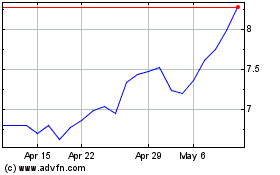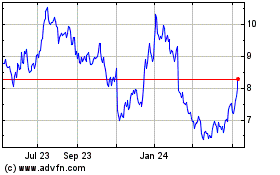By Costas Paris
Two months after a near complete standstill in China that
rattled global supply chains, the country's ports are again pushing
out thousands of containers that were stranded at the onset of the
coronavirus outbreak.
The massive buildup of boxes at docks in China has left a big
shortfall in cargo at ports in the U.S. and Europe since early
February, and created a shortage of empty containers that Western
exporters need to ship everything from farm products to electronic
parts. As China returns to work, fears are rising that the Western
ports won't be able to handle a flood of imports as seaports and
coastal cities face their own shutdowns and economic
disruption.
"There is a lot of relief that China is waking up after a long
hiatus," said George Lazaridis, head of research at Greece-based
Allied Shipbroking. "But what happens if truck drivers and crane
operators can't work in Hamburg, Rotterdam or Los Angeles and New
York. Who is going to pick up the boxes?"
U.S. and European ports have generally been operating normally,
although many sites have reported sharply reduced business as
global trade has slowed under the pandemic.
Shipping executives said they are taking new precautions to
protect their own workers and that disruptions could come if some
port workers get sick and are quarantined or if authorities impose
blanket public lockdowns for an extended period.
"While the situation is improving in Asia, especially China, new
measures have been taken in some other places to protect the health
of our staff," French container line CMA CGM SA said in a notice
late last week. "As far as France, all staff members will work from
home until further notice."
China government figures show container volumes at the country's
largest eight ports fell 19.8% in February, during the peak of the
lockdowns that Beijing imposed, from the year before.
Container volumes from China into California's three largest
seaports -- Los Angeles, Long Beach and Oakland -- were off 35.2%
in February from a year ago, according to trade data research group
Panjiva. The neighboring ports of Los Angeles and Long Beach, which
together make up the largest U.S. gateway for imports from Asia,
handled 132,564 fewer containers in February than they did the same
month a year ago.
The Port of Seattle closed operations at two of its four
container terminals Friday because of diminished shipping
demand.
The Port of Houston on Thursday said it had suspended operations
at its two main container terminals after a staffer who works at
both sites tested positive for the coronavirus.
Gene Seroka, executive director at the Port of Los Angeles, said
he doesn't expect the same sort of virus disruptions that crippled
Chinese megaports like Shanghai and Ningbo last month.
Thousands of boxes piled up at those ports as truck drivers,
crane operators and other workers couldn't go to work because they
were either sick or quarantined.
"We never saw a port closure in China, and I don't believe we'll
see a port closure here in Los Angeles," Mr. Seroka said. "We have
100,000 people and none work concurrently, or at the same time. I
believe we will have an ample workforce that is healthy and has the
ability to flex based on the needs of cargo flow and personal
health and safety requirements."
Liner operators said they would deploy their biggest ships to
pick up cargo from China, regardless of the situation at Western
entry points.
The 2M Alliance, made up of A.P. Moller-Maersk A/S and
Mediterranean Shipping Co., said last week they are boosting their
capacity of four weekly sailings to Los Angeles and Long Beach.
MSC sent one of its biggest ships -- the MSC Oscar, with
capacity for 23,000 20-foot containers -- into Los Angeles on
Sunday, and three other big vessels are expected to arrive by the
end of March. These giants are normally on the Europe-Asia trade
lanes, and their deployment in the Pacific points to increased
trade activity.
"It's like the roll of a dice to go full steam for China cargo,"
said the chief operations officer of a big Asian shipowner that
charters ships to container lines. "Our sailings take weeks or
months, but the situation with the virus closures changes every
day. If the U,S. closes down, I don't know what will happen with
the cargoes."
"Chinese port call activity returning to 2019 levels supports
reports that efforts to 're-start' the Chinese economy may be
gaining traction," said Clarksons research head Stephen Gordon.
"Given China's role as shipping's biggest market -- 22% of global
imports -- this is encouraging, as are the range of tariff
reductions, stimulus packages and policies being adopted
globally."
Liners canceled more than half of all sailings to China in
February, when infections reached a peak in that country. The virus
outbreak coincided with the Chinese New Year holiday, a period when
industrial output in China usually slows down.
Lars Jensen, chief executive of Copenhagen-based SeaIntelligence
Consulting, said canceled sailings are back to normal levels at
this time of the year but that more disruptions may come as the
coronavirus pandemic rolls across cities in Europe and Asia.
Mr. Jensen compares the hit to shipping companies to the
financial crisis in 2008, when container volumes contracted 10%. A
similar retrenchment now would mean a loss of 17 million containers
for shipping companies.
"It's a massive damage, even if we later get a V-shaped
recovery," he said.
Write to Costas Paris at costas.paris@wsj.com
(END) Dow Jones Newswires
March 19, 2020 16:06 ET (20:06 GMT)
Copyright (c) 2020 Dow Jones & Company, Inc.
AP Moller Maersk AS (PK) (USOTC:AMKBY)
Historical Stock Chart
From Dec 2024 to Jan 2025

AP Moller Maersk AS (PK) (USOTC:AMKBY)
Historical Stock Chart
From Jan 2024 to Jan 2025
